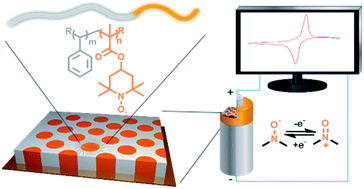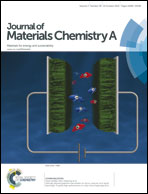Nanostructured organic radical cathodes from self-assembled nitroxide-containing block copolymer thin films†
Abstract
This contribution describes the formation of nanostructured thin film organic radical cathodes. First, the self-assembly of poly(styrene)-block-poly(2,2,6,6-tetramethylpiperidinyloxy-4-yl methacrylate) (PTMA-b-PS) diblock copolymers is detailed. In order to improve the nano-morphology of the immiscible PTMA and PS domains, the effect of thermal and solvent annealing is investigated. The formation of thin films with different morphologies such as cylindrical or lamellar nanostructures is observed depending on the processing conditions. The electrochemical properties of the nanostructured films are further investigated to assess the redox activity of the PTMA domains. Cyclic voltammetry of PTMA-b-PS diblock copolymers, either in dissolved or thin film supported configuration, confirms the reversible redox behavior of the nitroxide radical. Galvanostatic cycling of the thin film nanostructured cathodes reveals good capacity retention with fast charge/discharge response resulting from efficient charge and ion transfer as well as structural integrity. Such nanostructured organic radical cathodes provide opportunities for the fabrication of new generation nanostructured organic radical battery architectures.


 Please wait while we load your content...
Please wait while we load your content...